the health strategist
institute for strategic health transformation
& digital technology
Joaquim Cardoso MSc.
Chief Research and Strategy Officer (CRSO),
Chief Editor and Senior Advisor
October 26, 2023
One page summary
What is the message?
In the realm of banking and financial institutions, the use of technology for verifying customer identities surpasses the capabilities of human operators.
The article underscores the growing prominence of AI-driven identity verification as a more accurate and secure alternative.

What are the key points?
Machines Excel at Facial Recognition:
The article highlights that machines, equipped with facial recognition technology, are not only faster but also more accurate at recognizing faces compared to human counterparts. Studies reveal that machines perform as well as professional facial examiners, often employed in law enforcement.
Precision in Image Analysis:
Machines excel in image analysis by considering various factors such as the distance between facial features and the size of marks. This precision ensures a more reliable matching process, addressing challenges humans face, such as reconciling present appearances with outdated ID photos.
Continuous Improvement:
Technology, specifically machine learning models, continuously enhance their accuracy over time. For instance, Onfido, a UK-based digital identity verification provider, employs machine learning to refine its system’s performance. It can also identify attempts to link the same face with different names, enhancing security.
Preference for Online Verification:
Online customer onboarding is increasingly favored for its security benefits, with the process occurring entirely within a banking or payment app. This approach minimizes vulnerabilities associated with traditional methods, like call centers, which can be exploited by cybercriminals.
Sophisticated Checks:
Beyond facial recognition and document verification, more sophisticated checks occur behind the scenes. This includes examining additional signals, such as IP addresses, phone number histories, and email addresses. These data points are used to determine the authenticity of a customer and distinguish genuine onboard users from potential fraudsters.
Behavioral Biometrics:
The evolving field of behavioral biometrics is of growing interest to fintech companies like Revolut. This involves profiling user behaviors, such as how they hold a device or type, to further authenticate identity and enhance security.
Statistics
- Over 30 million online customers worldwide use Revolut, a UK fintech that relies on advanced identity verification.
- The “vast majority” of customer onboarding is now performed online, according to Onfido.
- Machines have been proven to perform at the level of “professional facial examiners” in facial recognition tasks.
Examples
- Revolut uses a combination of internal models and external vendor services to combat the constant threat of AI-generated images and deep fakes being presented as genuine.
- Onfido suggests that utility bills and similar records are not the most secure means of verifying someone’s identity, emphasizing the need for more advanced technology.
- Behavioral biometrics, like profiling user device angles and typing speed, are emerging as promising tools to authenticate identity once the onboarding process is complete.
Conclusion
The article underscores the superiority of technology, particularly machine-driven facial recognition, in verifying customer identities for banks and financial institutions.
It emphasizes the continuous improvement and security enhancements offered by technology, making it the preferred choice for customer identity verification in the modern financial landscape.
DEEP DIVE

This summary is based on the article “Why is technology best for checking bank customer identities?”, published by the Financial Times and written by Laura Noonen, on October 23, 2023.
To read the original article, access https://www.ft.com/content/2c5291ae-2f31-439d-8176-a669a88d41e0











